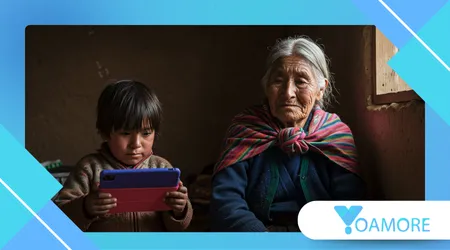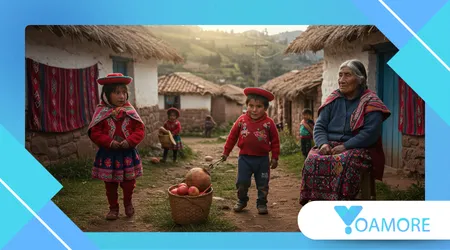When Children Stop Speaking Their Grandparents’ Language: The Quechua Crisis

When children stop speaking their grandparents’ language, a cultural fracture begins—quietly, but irreversibly.
Anúncios
In the Andes, this rupture threatens Quechua, the oldest living Indigenous language in the Americas.
Summary:
The decline of native languages is not just a linguistic issue—it’s a cultural, economic, and emotional rupture. In this article, we explore the Quechua language crisis in South America.
We examine the causes, consequences, and possible solutions to this intergenerational disconnection.
Using real data and original examples, we reflect on what it truly means when children stop speaking their grandparents’ language—and what can still be done to reverse this global pattern.
Anúncios
The Hidden Cost of Language Loss
When children stop speaking their grandparents’ language, something far greater than grammar is lost. It’s a thread that ties generations, customs, and worldviews.
In the case of Quechua—a language once spoken by the Inca Empire and now by approximately 8 million people across the Andes—this disconnect is reaching a critical point.
Despite being the most spoken Indigenous language in the Americas, Quechua has seen a sharp decline in fluent speakers under 25.
The issue isn’t only about forgetting words—it’s about losing access to ancestral knowledge, agricultural practices, oral histories, and a communal identity rooted in language.
The stakes are profound. Each time a child grows up without their ancestral tongue, a piece of culture, tradition, and resilience disappears.
It’s not an isolated phenomenon, but a global one that reflects how colonialism, migration, and modern education systems affect Indigenous identity.
Also Read: The Forgotten Kingdom of Tartessos
Quechua: More Than Words

To truly grasp what’s at stake, we must understand Quechua not just as a linguistic tool, but as a living ecosystem.
It’s embedded in the rhythm of farming, the philosophy of reciprocity (ayni), and the spiritual vocabulary used in Andean rituals.
It is a language that defines a way of being in the world, not merely a way of speaking about it.
Yet, as urban migration intensifies and digital content remains overwhelmingly monolingual, children increasingly grow up in environments where Quechua feels irrelevant or even shameful.
And so begins the silent departure from the language of their roots.
The erasure begins in small moments: a child teased at school for speaking Quechua, a job interview where Spanish is the only acceptable option, or parents avoiding teaching the language at home in fear of limiting their children’s futures.
But the consequence is deep: intergenerational bonds break down, traditional wisdom becomes inaccessible, and communities lose their linguistic compass.
+ The Tuvan Throat-Singing Language and Its Cultural Soundscape
Why Families Are Letting Go
The reasons are complex—and deeply human. Many parents and grandparents believe they are giving their children a better future by speaking only Spanish or English at home.
They fear social exclusion, academic disadvantage, or economic barriers tied to speaking an Indigenous language.
A 2023 report by UNESCO revealed that 45% of Quechua-speaking families in Peru had stopped teaching the language to children, citing discrimination and limited opportunities for speakers in urban labor markets as the primary reasons.
The choice to “protect” children from their own linguistic heritage becomes, unintentionally, a path to cultural erasure.
In some families, the decision is unspoken. It happens gradually, as priorities shift, as grandparents age, and as younger generations immerse themselves in dominant cultures.
It’s not always neglect—it’s often survival. But the emotional toll on identity and belonging can be enormous.
+ Indigenous Voices: The Battle to Save Native Languages
A Language Caught Between Past and Future
Imagine cutting down a tree to build a house, only to realize years later that the shade, fruit, and shelter it once gave are irreplaceable.
When children stop speaking their grandparents’ language, it’s a similar kind of loss—one not immediately visible, but deeply felt over time.
The decline of Quechua is not a matter of nostalgia. It signals a profound imbalance in how modernity values knowledge systems. Western science is celebrated; Indigenous wisdom is sidelined.
In Peru, for example, Quechua agricultural techniques have sustained Andean soil for centuries, yet they are rarely taught in agricultural schools.
This cognitive inequality further isolates Quechua from the curriculum and economy, pushing it deeper into invisibility.
Without strong policy interventions and cultural revalorization, this trend will only accelerate.
The Digital Dilemma and Youth Disengagement
The rise of global media, social networks, and streaming platforms has intensified the crisis. Quechua is barely represented in film, television, or online education.
Most children today consume media in Spanish, English, or Portuguese.
As a result, Quechua becomes increasingly confined to rural spaces or folkloric performances, rather than seen as a viable, modern means of communication.
A study published by the University of San Marcos in 2023 found that fewer than 5% of digital educational resources in Peru offer Indigenous language options.
Without access to apps, games, or learning platforms in Quechua, young learners are discouraged from valuing their linguistic heritage.
Still, a few pioneering projects offer hope. Apps like Tinkuy, open-access dictionaries, and YouTube channels such as Quechua para Todos are trying to bridge the generational gap by making Quechua accessible and engaging.
But the scale of these efforts is dwarfed by the sheer volume of content in dominant languages.
Cultural and Psychological Impact
Language extinction isn’t only cultural; it has real socio-economic costs.
Bilingual children who retain Indigenous languages tend to have stronger community ties, better self-esteem, and greater adaptability in cross-cultural environments.
In contrast, studies have shown that young Quechua speakers who abandon the language often experience a loss of identity.
This “cultural dislocation” can impact mental health and even academic performance. Children grow up unable to communicate with elders, creating a painful disconnect during critical formative years.
A young girl in Cusco shared during a 2024 workshop by Wikimedia Peru that she felt “incomplete” not understanding the Quechua blessings her grandmother spoke daily.
Language, for her, was no longer just about communication—but about memory and connection.
One Language, Many Realities
Quechua is not a monolith. It has several dialects, regional variations, and forms of expression. Some communities preserve ceremonial uses, while others adapt it to urban slang and digital terms.
This diversity should be an asset. But instead, it often becomes a barrier to standardized education or policy support.
Recognizing and supporting this complexity is essential for revitalization. Quechua’s richness lies in its flexibility—its ability to evolve while honoring its roots.
There are modern poets writing in Quechua, coders building AI voice models with it, and teachers integrating Quechua literature into urban classrooms.
These stories, though few, illustrate the language’s potential for the future.
Data Speaks: Where Quechua Stands Today
| Country | Total Quechua Speakers | Under 18 Speakers (%) | Decline Rate (2010–2024) |
|---|---|---|---|
| Peru | 3.8 million | 21% | -32% |
| Bolivia | 1.7 million | 18% | -27% |
| Ecuador | 500,000 | 13% | -41% |
Source: UNESCO Language Vitality and Endangerment Report, 2024
Policy, Education, and the Role of Technology
The question is no longer if Quechua is at risk—it’s how we can respond. Solutions must be multi-layered:
Educational reform is urgent. Quechua should not be offered as an optional “cultural enrichment” subject, but as a core language with intellectual and professional value.
Teachers must be trained, and curricula should reflect the linguistic diversity of the Andes.
Media and entertainment also play a key role. Streaming platforms like Netflix have begun experimenting with Quechua subtitles.
Imagine the impact if popular children’s shows included Quechua dialogue or cultural references—normalizing and celebrating the language for millions.
Government-led projects such as Peru’s Programa de Educación Intercultural Bilingüe show promise but face funding gaps and inconsistent reach.
Collaboration with NGOs, local artists, and Indigenous organizations could amplify these efforts.
Globally, initiatives like Endangered Languages Project offer tools, resources, and visibility to speakers and educators worldwide, creating digital bridges that connect traditions with tomorrow.
Conclusion: Listening to What Hasn’t Been Said
Ultimately, when children stop speaking their grandparents’ language, the silence that follows echoes far beyond words—it resonates in identity, belonging, and purpose.
But silence can be broken.
We are still in time to reverse the trend, not by forcing tradition, but by celebrating it, adapting it, and weaving it into the lives of new generations.
What seems like a personal choice—language—carries collective consequences. And within that truth lies the power of change.
Language is not static. Neither is culture. If Quechua is to thrive, it must live in the laughter of children, the lyrics of new songs, and the lines of tomorrow’s code. It deserves more than survival—it deserves celebration.
Frequently Asked Questions
1. Is Quechua considered endangered?
Yes, particularly among younger generations. While still spoken by millions, its transmission rate to children is alarmingly low, especially in urban areas.
2. Are there modern resources to learn Quechua?
Yes. Apps, community classes, and online platforms like Quechua Language Resources offer structured learning tools, though access can vary by region.
3. Can Quechua be integrated into modern careers?
Absolutely. Quechua-speaking professionals are in demand in tourism, education, translation, and cultural preservation. Its inclusion also enhances diversity and outreach.
4. What countries recognize Quechua officially?
Peru, Bolivia, and Ecuador have given Quechua official status, though implementation of policies and public services in the language remains inconsistent.
5. How can families help revive Quechua?
By speaking it at home, seeking resources, involving children in cultural traditions, and advocating for better education in Indigenous languages.
